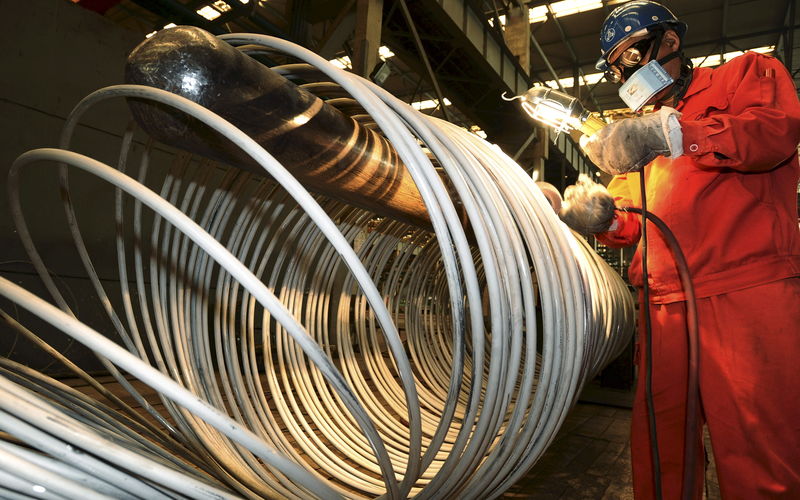(Repeats with no changes to text)
By Clyde Russell
LAUNCESTON, Australia, Nov 18 (Reuters) - - Nobody is happy with China's steel sector, certainly not producers in the rest of the world complaining about dumping and not even the Chinese, who are battling increasing losses amid a supply glut.
But the question remains as to whether enough is being done, or is likely to be done, to resolve the situation.
Record low prices, increasing calls from the rest of the world's steelmakers for measures to halt the flow of cheap Chinese exports are adding to China's steel woes.
And this pressure is only likely to increase in coming months, as shown by claims in Australia that not only are Chinese steel imports killing the local industry, they may end up killing locals by being of inferior quality.
The quality issue is an example of a potential new front in the war against China's steel exports.
The Australian Steel Institute and the Welding Technology Institute of Australia said that some imports from China have serious quality defects, according to a report on Tuesday on the Australian Broadcasting Corporation.
"We've seen some examples of that and it's quite dangerous," Welding Institute chief executive Geoff Crittenden told the public broadcaster.
"What concerns us most of all is there's going to be a terrible accident, and that's unacceptable," he said.
While not taking a position on the validity of his arguments, it is possible to see how a campaign against Chinese steel on safety grounds could gain public and government support.
The Steel Institute wants third party accreditation to be conducted on steel manufacturers overseas to ensure their products meet Australian standards.
While this would go some way to solving any quality issues, it will also push up costs for steel imports, thus providing some relief to Australia's steel sector, which has recently shed hundreds of jobs and cut worker benefits in a bid to survive.
ACTION AGAINST IMPORTS TAKES TIME
British steel plants shed nearly 4,000 jobs in October, resulting in the industry calling for immediate action from the European Union to halt alleged dumping of Chinese steel products.
However, a meeting of EU ministers on Nov. 9 failed to agree on urgent measures, and in the time-honoured tradition of the economic bloc all that was agreed was that the situation was serious and action needed to be taken, with Luxembourg, which holds the rotating EU presidency, proposing a conference later this year.
U.S. steelmakers have filed a complaint with the government about steel imports from five countries, including China as well as India, Italy, South Korea and Taiwan, claiming that the industry in those nations is subsidised.
However, given the bureaucratic nature of resolving complaints, it may take as long as a year for the U.S. authorities to come up with a determination as to whether steel is being dumped, and what penalties should be imposed.
India has taken action against steel imports, imposing a 20 percent duty in September on some products from China, Japan, South Korea and Russia.
But even though it may take time for the EU, the United States and others to impose duties on China, the trend is becoming clear, namely, China's ability to export its way out of overcapacity is about to be curtailed.
Already, steel exports appear to be heading lower, with October shipments of 9.02 million tonnes being 19.8 percent below September's level. Year-to-date steel exports are still up 24.7 percent, but this figure has been trending lower since peaking at 56.4 percent in February.
DOMESTIC DEMAND CAN HELP - A LITTLE
If exports aren't the panacea for China, is there hope for a domestic demand-led recovery on the back of increased infrastructure spending?
While there is some optimism that Beijing will prime the infrastructure pump once more, it's highly unlikely that the taps will be opened far enough to make a significant dent in China's overcapacity.
Chinese steel mills can produce around 1.1 billion tonnes a year, but apparent consumption dropped 5.7 percent to 590.47 million tonnes in the first 10 months of 2015, compared to the same period last year, according to the China Iron & Steel Association.
If this pace is maintained for the full year, it implies domestic demand of about 708 million tonnes, and exports of perhaps as much as 110 million tonnes give a total of about 818 million tonnes.
This means that there is still at least 300 million tonnes of spare capacity in the Chinese steel sector, which indicates closures of 50 million tonnes so far this year is only just a start in addressing the supply glut.
While Beijing may be keen to see further rationalisation in the steel sector, it becomes more complicated when the needs of local governments are factored in, as these entities are more likely to try and keep mills open in order to keep employment levels high.
What has been seen in other oversupplied industries, such as aluminium, is that excess capacity takes longer than expected to exit the market, and tends to come back quite quickly when prices improve.
The benchmark Shanghai steel rebar contract hit a fresh record low in early trade on Wednesday of 1,745 yuan ($273.64) a tonne, a loss of 74 percent from its peak in August 2009.
The slumping price will no doubt add to pressures on loss-making steel mills, but it's also likely that if enough do shut and the price rallies, some will restart, thus capping any gains.
If there is a common theme in the current commodity rout, it's that excess supply is stickier than what is logical and that price rallies quickly lead to supply returning.
This suggests there is still much pain to come for Chinese steelmakers, and their global counterparts.
(Editing by Joseph Radford)
